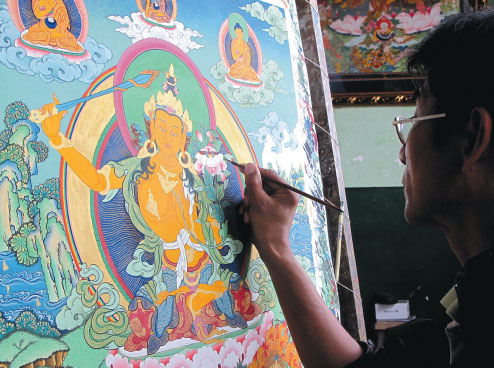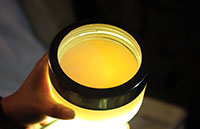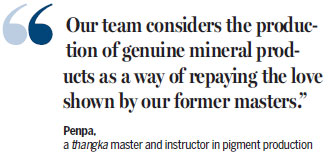Pigment producers push to protect ancient art
Updated: 2015-07-16 07:51
By Palden Nyima(China Daily)
|
|||||||||||
 |
|
Samdrub,a thangka artist, uses traditional Tibetan mineral pigments on a thangka in his workshop. [Photos by Palden Nyima/China Daily] |
The Tibet autonomous region is famous for its elegant, colorful architecture, especially its Buddhist temples. However, some traditional handicrafts and skills are being lost as the region engages ever more closely with the modern world. Palden Nyima reports from Lhasa.
For most people, the phrase "Tibetan art" calls to mind images of a range of handicrafts, including traditional scroll paintings, known as thangkas. However, few people are familiar with the pigments that artists in the Tibet autonomous region use to paint the thangkas.
The production of mineral pigments is an ancient art in Tibet, but it's heading for extinction at a rapid pace. "The production of mineral pigments is an interesting part of Tibetan traditional culture that was inherited by our ancestors. We want to ensure that it lasts forever," said Penpa, a thangka master and instructor in pigment production in Lhasa, the capital of Tibet.
"Our team considers the production of genuine mineral products as a way of repaying the love shown by our former masters," the 43-year-old said. "I consider the work to be a contribution to the continuation of our ancestors' valuable heritage."
While many people speak of innovation or "expanding" a heritage, Penpa simply wants to follow in his ancestors' footsteps without altering the ancient traditions.
"I don't want any breakthroughs to endanger the preservation of what our ancestors left for us. That would be enough," said Penpa, who works for Lhasa Ancient Architectural Arts Co, a 30-year-old outfit that operates one of just three pigment workshops in the region.
Most of the company's work involves the restoration and refurbishment of ancient architecture, and the production of mineral pigments is one of its core businesses.
Although some producers sell pigments that contain a mixture of mineral pigments and modern, synthetic dyes, Penpa's company only produces and sells genuine Tibetan pigments. "Real Tibetan pigments are made from mineral stones and plants. The other pigments in the Tibetan market are produced in other Chinese provinces and in India," he said.
Today's Top News
France returns 32 cultural relics to Chinese museum
Mayor to turn Zhanjiang into green economic powerhouse
Private firms' access to arms sector widens
Warren Buffett, Johnny Depp buy Greek islands
China, World Bank pledge $50m for poor
Web companies asked to support 'digital Silk Road': Zhanjiang forum
Risks growing for cybersecurity
China's stock wobbles may deter foreign investors - for now
Hot Topics
Lunar probe , China growth forecasts, Emission rules get tougher, China seen through 'colored lens', International board,
Editor's Picks

|

|

|

|

|

|







